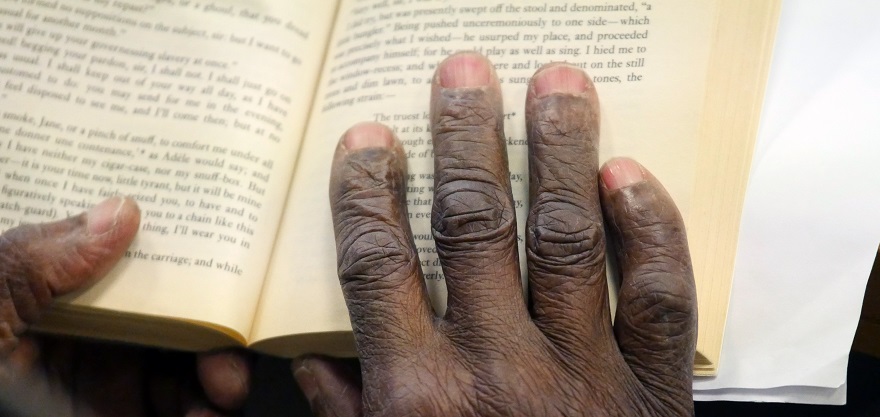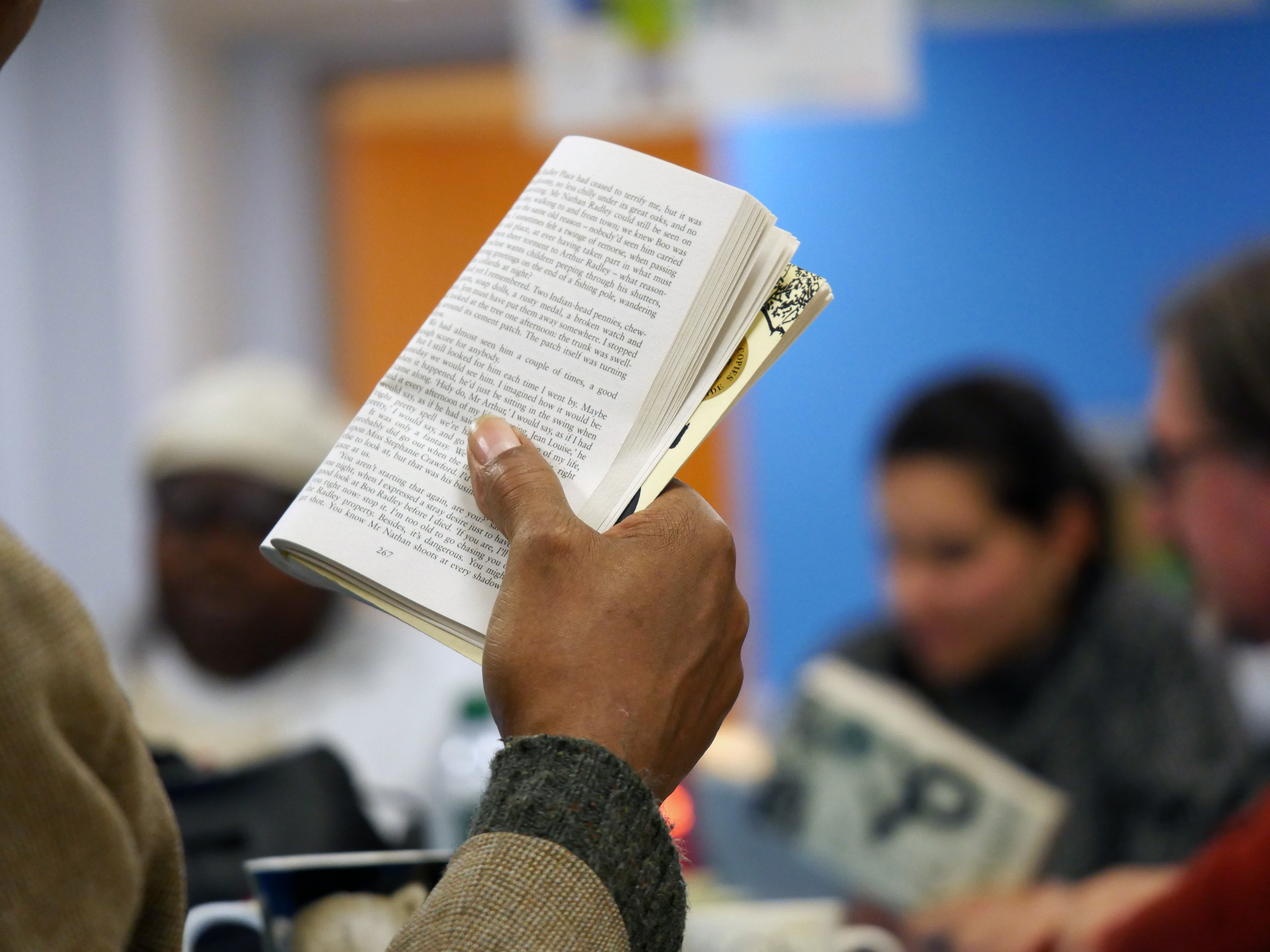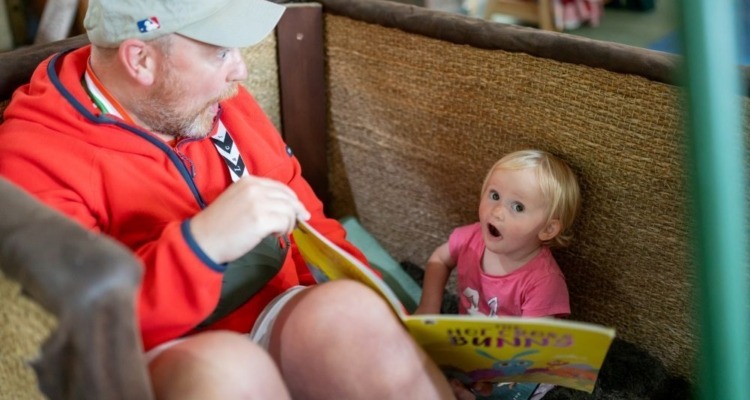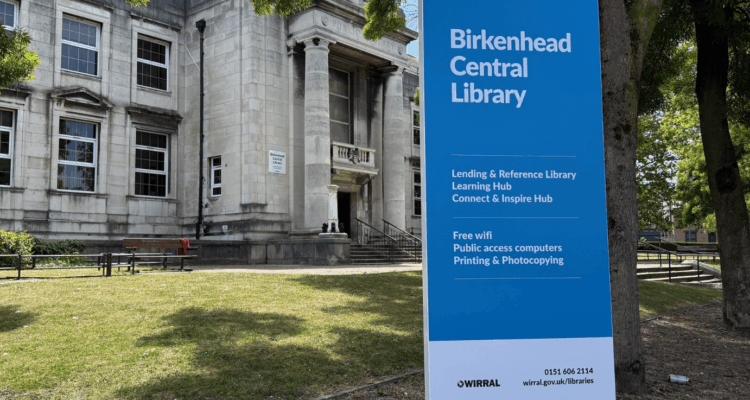People with lives: Combating chronic pain through Shared Reading

Can you combat chronic pain through Shared Reading? Kate, who runs the chronic pain reading group at Broadgreen Hospital in Liverpool tells us how it can be as effective as traditional therapies.
The Reader recently learnt that our Shared Reading group at Broadgreen Hospital in Liverpool has been recommissioned for the next five years – a great vote of confidence in its worth - but what is chronic pain and how does Shared Reading help?
"We're all broken people, but we're able to find some wholeness here..." - Group Member
An article in The Times today describes how people with chronic pain, who were played images of themselves for two minutes via a head-mounted camera feed, found temporary relief through the illusion of ‘leaving their body behind’.
The Reader has been running a Shared Reading group at Broadgreen Hospital for people living with chronic pain since 2013 and benefits to patients include the sort of ‘immersion’ and relief from pain described within The Times article, but also longer lasting effects: improvements in sleep, mood, ability to cope and general quality of life, as well as a reduction in social isolation:
"The way we’ve all been this afternoon – you’d never think we were all in pain, would you?"
‘Coming here has saved my life.’
‘‘I go out of here with a spring in my step.’
- Group Members
What is Chronic Pain?
Chronic pain is defined by the International Association for the Study of Pain as ‘an unpleasant sensory and emotional experience associated with actual or potential tissue damage, or described in terms of such damage’.
It is a pain which persists for more than six months and ‘unpleasant’ is a huge understatement. What patients really have is suffering .
Defining pain as an ‘emotional’ experience is crucial. Usually pain is picked up by specialised cells in the body and impulses are sent through the nervous system to the brain.
What happens in people with chronic pain, however, is that other nerves are recruited into this ‘pain’ pathway which starts to fire off messages to the brain when there is no physical stimulus or damage. Pain is a complex feeling that affects thought, mood and behaviour and often leads to isolation, immobility and drug dependence.
In that respect, chronic pain reassembles depression, and the relationship is intimate. Pain is depressing and depression causes and intensifies pain. People with chronic pain have three times the average risk of developing psychiatric symptoms and depressed patients have three times the risk of developing chronic pain.

The reading group at Broadgreen Hospital has been the subject of two research projects conducted by CRILS (the Centre for Research into Reading, Literature and Society) at The University of Liverpool and findings have helped convince commissioners that Shared Reading is an intervention which can help people for whom pain is, as one group member put it, ‘a life sentence’.
The first of CRILS’ reports found that the mental challenge of Shared Reading created a state consistent with the concept of ‘flow’, whereby people can relinquish awareness of their physical needs and bodily state, ‘becoming more fully themselves – more fulfilled and absorbed, more vitally alive – in forgetting the self, whilst engaged in meaningful activity’.
Participants - regardless of previous reading experience - universally showed a preference for intellectually and emotionally demanding literary pieces which produced closer concentration and absorbed attention, reducing awareness of pain – ‘as though the extra mental effort helped shift immersion to another level and blocked out the pain more successfully’.
The most recent of CRILS’ reports, published earlier this year, compared CBT (Cognitive Behavioural Therapy - a recognised intervention for chronic pain and depression) with Shared Reading.
The report suggests that Shared Reading’s encouragement of greater confrontation and tolerance of emotional difficulty through engagement with literature makes it valuable as a longer term follow up or adjunct to CBT’s concentration on short term management of emotion.
The spontaneous and independently constructed patterns of thinking sparked by Shared Reading at points of personal readiness make it an important complement to CBT’s expert-led ‘top down’ taught techniques of mind over matter.
‘When people are in CBT, they are people with pain. When they’re in the reading group they’re people with lives.’ - Dr Andrew Jones, Consultant in Anaesthesia and Pain Medicine
Group members range in age from 35 to 75 and experience a wide variety of conditions, including fibromyalgia and peripheral neuropathy, and with their initial experience of pain emanating from accidents, strokes, unsuccessful surgery or illnesses.
In one session, several people recognised for themselves how ‘flow’ is produced in the group when through spontaneous responses to the poem Labor by Baron Wormser which describes how we can get lost in physical work (lumber-jacking in this instance):
I was the maul coming down kerchunk
On the round of maple; I was the hellacious
Screeching saw; I was the fire.
I was fiber and grew imperceptibly.
‘That’s like us – we all forget our pain when we’re here and get lost in the story’
‘This is the closest thing I ever get to work’.
- Group Members
Pain is diminishing and dominating – it can shrink personhood to almost nothing – but Shared Reading puts group members back in touch with their larger selves, the people they were before they had pain, and reminds them that they still have that within them, as one group member, who is a wheelchair-user describes:
‘The family have recognized the change in me. They can see how I am more positive. If you can increase positivity to another level you know it is like flying, walking on water really, but also it is, you know, it just helps me cope more with things...’ - Group Member
Share
Related Articles

We cannot just tell parents to read more. To truly improve children’s futures through reading, we need to properly support the adults around them to do so.
Responding to the Department of Education's announcement that 2026 will be a Year of Reading, The Reader's Managing Director Jemma…

Shared Reading in Wirral Libraries: ‘As a kid people read stories to you but as an adult you lose that – and it’s a fantastic thing to do!’
Two Strategic Librarians for Wirral Libraries, Kathleen McKean and Diane Mitchell have been working in partnership with the UK’s largest…

Open Air Cinema and Theatre FAQ’s
If you were able to snap up tickets to our Open Air programme this summer, check below for any queries…



